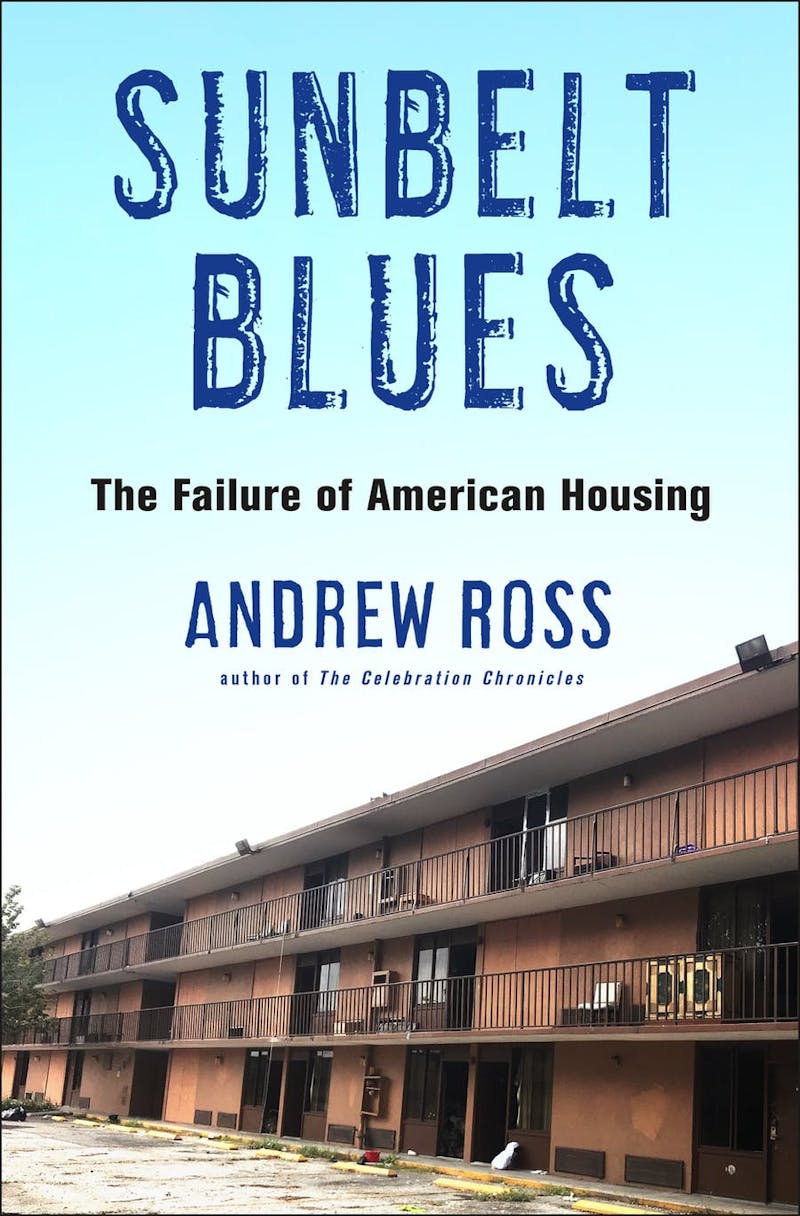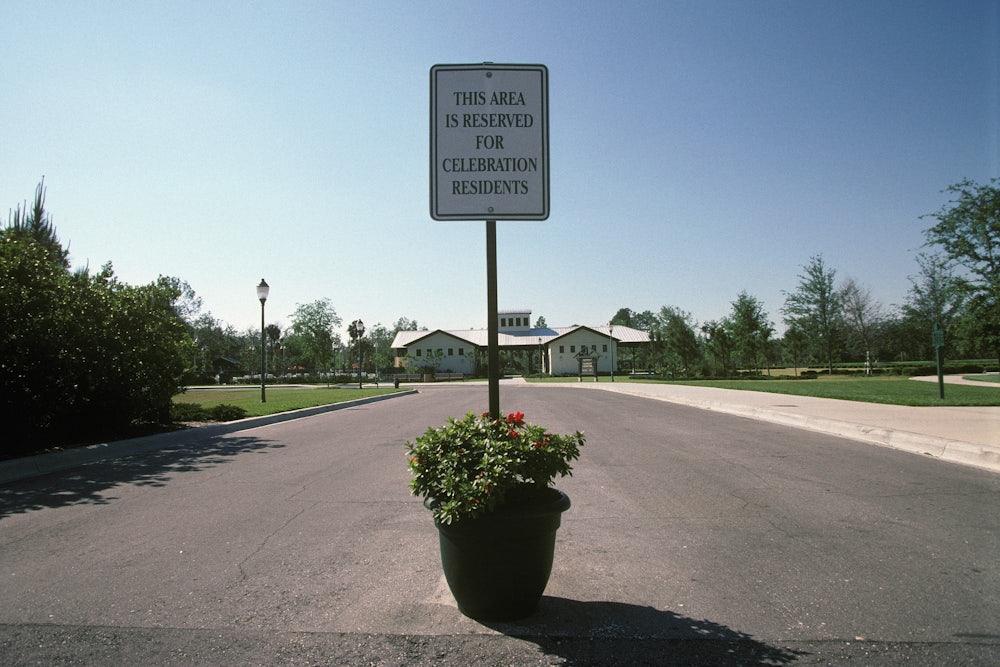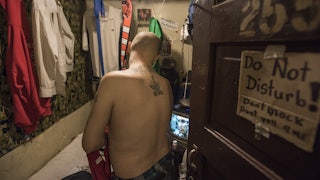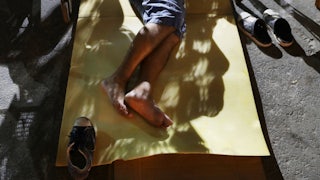Osceola County, Florida, begins at the Southern gates of Disney World and stretches down U.S. Route 192, a drag lined with mini-malls, evangelical churches, flea markets, pawn shops, and dollar stores. In his new book, Sunbelt Blues: The Failure of American Housing, Andrew Ross describes the county’s two distinct housing markets: There is the 15-bedroom home in Reunion that rents for $50,000 a week for VIP Disney visitors, and there are the $40 motel rooms for those turfed out of their apartments.

The second market is much larger. One in every 100 homeless children in the United States lives in the Orlando metropolitan area. Some people who can no longer pay the motel rates set up camp in the nearby swamp—it is not bad compared to the noise, drug deals, and bedbugs of the motels: that is, if the alligators stay away. Motels, campsites, and parked cars on Route 192 house much of the informal labor force that keeps the magical kingdom and the area’s tourism economy running, but far from the gates of the palace. Sunbelt Blues tells the story of those barely hanging onto a home in the shadow of America’s leading corporate producer of fantasies.
It wasn’t meant to be this way. In the 1990s, the Disney Corporation developed the model suburb of Celebration in Osceola County. It was both a conversation piece about what the ideal American community should look like and a canny foray into residential real estate for a tourism destination surrounded by rising land prices. And to the planners’ credit, they wanted to use the new town to put New Urbanist thinking into practice. With its mixed commercial and residential uses, pedestrian-friendly streets, and cutting-edge postmodern architecture by the likes of Philip Johnson and Michael Graves, Celebration promised a bit of a reprieve from banal, unwalkable suburbia.
Ross, a cultural studies professor and arts activist, wrote a book about Celebration 22 years ago, uncovering some of the early tensions in a place heralded as a high-minded experiment. Sunbelt Blues is a kind of ethnographic revisit: a check-in with old research subjects to see how things are going. The answer is discouraging. The intervening decades have left the town a waterlogged, weather-beaten version of its former self. Once featured in the pages of Architectural Digest, it is now reported on as an example of what happens when vultures from Wall Street gobble up condominiums, load up debt, and skimp on maintenance (even on leaky roofs that let in the copious Florida rain).
Yet, as Ross discovers through several years of living in “last resort” motels up and down Route 192, Celebration residents are the lucky ones. The more common situation in Osceola County is tremendous housing insecurity, even for those fortunate enough to be employed smiling for visitors in front of the blue-turreted Cinderella Castle. Sunbelt Blues details a new housing economy split between luxury Airbnbs and mansions with three-car garages and, just a few miles away, weekly rental motels, trailer homes, and campsites. It is no accident that the divide is deepening in a place with rising property values and a major employer that pays poverty wages for intense physical and emotional labor. Like a medieval castle, Disney World relies on an illusion, where the comfort of the feted guests is sustained by staff who can barely get by in packed garrets, cellars, and even camps out near the edge of the ramparts.
Most people do not think of motels when they imagine homelessness. Someone who is homeless is often pictured as middle-aged, unemployed, and male, with substance abuse issues, sleeping rough in a park or under a bridge. Yet homelessness is a spectrum. One of the fastest-growing groups of people without housing is older women lacking pensions. First denied a spot in the labor market, or paid lower wages than their male co-workers, older women face more vicissitude as they age, even if they make it to the Sunshine State, America’s retirement mecca. Others who are struggling to survive in the motels of Route 192 are the underemployed, people with drug problems, those with bad credit, or hurricane refugees from Puerto Rico.
Many without long-term housing do have consistent work: Their jobs just pay so poorly that making a deposit and monthly rent for an apartment is impossible. Some of the unhoused even work for Disney and, as Ross points out, the “grim living conditions make for a stark contrast with the cheery emotional labor required from cast members.” Housing insecurity involves couch surfing, sleeping in cars, getting a cut-rate motel room, living in an R.V., or pitching a tent. All of these means of securing affordable housing are endangered as land prices go up and building conventional housing becomes more profitable. When Ross visits those living on undeveloped marshland near the interstate, he finds complex communities, frequently of older people chatting about social security, Medicaid, and prescription drugs from their tents. Heartbreakingly, he also encounters people who have gone there with terminal illnesses waiting to die while seeking pharmacological solutions for their intense pain.
While shanties spring up in the woods, Florida’s real estate market is on fire, with home prices at an all-time high and new construction breaking ground wherever land is available. “The biggest transfer of this property wealth has occurred in Sunbelt states whose economies are fueled by an unwholesome cocktail of breakneck growth, hands-off regulation, depressed wages, and real estate speculation,” Ross tells us. Indeed, it is the Houstons, Orlandos, and Phoenixes that have boomed in recent years, with corresponding problems for those who are housing insecure. Many have suffered traumatic childhoods, addiction, and domestic abuse, adding immense psychological strain to the already heavy burden of poverty. The motels and then the illegal campsites of Route 192 are a last stop on a slide down the economic ladder, sometimes rationalized by those whose spiral has led them there:
Exposed to a variety of threats and harms, and at the mercy of Florida’s storms, hurricanes, and pitiless summer heat.… They make the most of their situation by developing views and beliefs that make it seem more voluntary—“life inside four walls is too claustrophobic for me”—but in most cases, they also admit that they would take a more comfortable or stable haven if it came their way.
The extended-stay motels and informal campsites are both hidden in Florida’s economy: One group lives as pretend tourists, the other is obscured by palms and split oak trees. While the state markets itself as a place to retire in giant geriatric preserves like The Villages (a master-planned 55-plus community of over 130,000 people), many older people also live in places like the unbecoming strip of Route 192, constantly worrying about where they will sleep next.
Motels—which in Florida and nationally are often immigrant-owned small businesses—have become the unintentional stopgap for state programs placed on anemic funding by governors like Ron DeSantis, and Rick Scott before him. The motel owners in Osceola County, many of them South Asian immigrants, frequently thought they were buying into the booming low end of Disney tourism, before they became de facto social service providers. They often divided their buildings in half: Long-term residents on one side and daily-rate tourists on the other. With the bust in tourism during the pandemic and the increase in unemployment, many motel owners found themselves running private shelters for people at risk of homelessness. Ross says he was usually placed on the “vanilla” side of the hotel due to being nonpermanent, but he would make his way over to the other side. “A motel is where you’re supposed to be on vacation,” one woman told him, continuing: “This is not a normal place to live, especially to raise a kid.” At the same time, many motel residents offer mutual support and easy socialization: making the best of what they know is not yet the worst.
Florida is the epicenter of America’s perverse new real estate reality. Prices boomed after a scarring 2008 subprime bust, luxury seaside villas sell at a premium in areas already flooding, and enormous wealth is co-located side by side with destitution. It is also a favorite place for hedge-fund housing buy-ups that have financialized real estate beyond any previous reckoning. The 2008 crisis was supposed to create accountability when it came to trading mortgages on global markets. What actually happened was that a temporary devaluation sent institutional buyers into depressed markets, like Orlando, with billions of dollars in funds in one hand and eviction notices in the other. While Ross completed this book largely before the pandemic, he makes it painfully clear that investors are once again circling distressed homeowners who are behind on their mortgages. They have even acknowledged building up their cash reserves to snap at deals when eviction moratoriums expire.
While the book is anchored in the decline of Celebration and the housing chaos of Route 192 just past its borders, the mouse ears nearby cast a big shadow. When Disney began to plan its flagship theme park in the 1960s, the Florida legislature vested the company with powers similar to an independent county’s. It was granted the right to behave like an autonomous city and soon began doing just that. Building Celebration seemed like a natural extension of these privileges and a demonstration of private managerial capacity. That is, until corporate control ran the community into the ground and devalued local homes.
Since then, Disney World has alternated between treating its neighbors and employees as part of a utopian undertaking and entirely ignoring them. Celebration at first was a mixed socioeconomic community with more affordable rental apartments interspersed with designer homes, all with a shared downtown that was lively and walkable. However, it never resembled a “company town.” This was both a good and a bad thing: There was never the fearsome control and price-fixing of Western mining towns, but nor did Celebration provide the subsidized housing and cultural amenities of places like the nineteenth-century city of Bournville, near Birmingham, U.K., created by chocolate-maker Cadbury. It was a real estate venture, not a solution for employee housing.
Celebration’s quick sale to Lexin Capital in 2004 dismembered the experiment before it even started, forking over the heart of the city for the low sum of $21 million. The private equity firm quickly sold off parking lots and undeveloped areas, decreasing amenities for residents. It also converted rental apartments into condos, reducing affordability and potentially affecting the class composition of Celebration. However, if Lexin had ever planned to make the town more affluent, it failed: Lawsuits, corporate debt, and deferred maintenance were all heavily publicized, and today Celebration is more populated with those who cannot leave due to lack of funds rather than residents attracted to the experiment, its architecture, or its investment potential. Disney’s willingness to pawn off its high-minded urbanist experiment for almost nothing and risk reputational damage due to subsequent mismanagement shows the corporate mentality of the past two decades: Long-term investments are not worth it, no one cares about anything but the bottom line, living wages and housing are someone else’s problem.
The coda to Ross’s adroitly written book focuses on the continued fallout of the coronavirus pandemic. Higher housing prices, less job security, and the search for work across state lines may normalize the peripatetic life of weekly motel rentals for the working class priced out of cities. A home is increasingly a thing that some people only dream about, while others own several and profit from listing them on apps: cleaned, booked, and banked-on from their smartphone. While the pandemic has led to more housing insecurity, it has not prompted new approaches to creating affordable housing at the state level. Florida is the optimal place to understand what’s gone so terribly wrong with housing. There is a lack of supply; statewide laws prohibit rent control; and counties resist building shelters, hoping to push the unhoused onto their neighbors; but the biggest problem may be that the state is a low-lying, flood-prone peninsula raked by hurricanes from both sides.
The question of why Florida is still one of America’s fastest-growing states is perplexing. Some Floridians are frank about the risks. One tells Ross that Osceola County is a good bet because development in Central Florida can serve as a fallback for when Miami sinks underwater in the next half-century. When that happens, a dilapidated motel room may sound pretty nice for climate refugees heading north. Until then, Florida’s solutions to the affordable housing crisis are pure Disney: fantastical.






